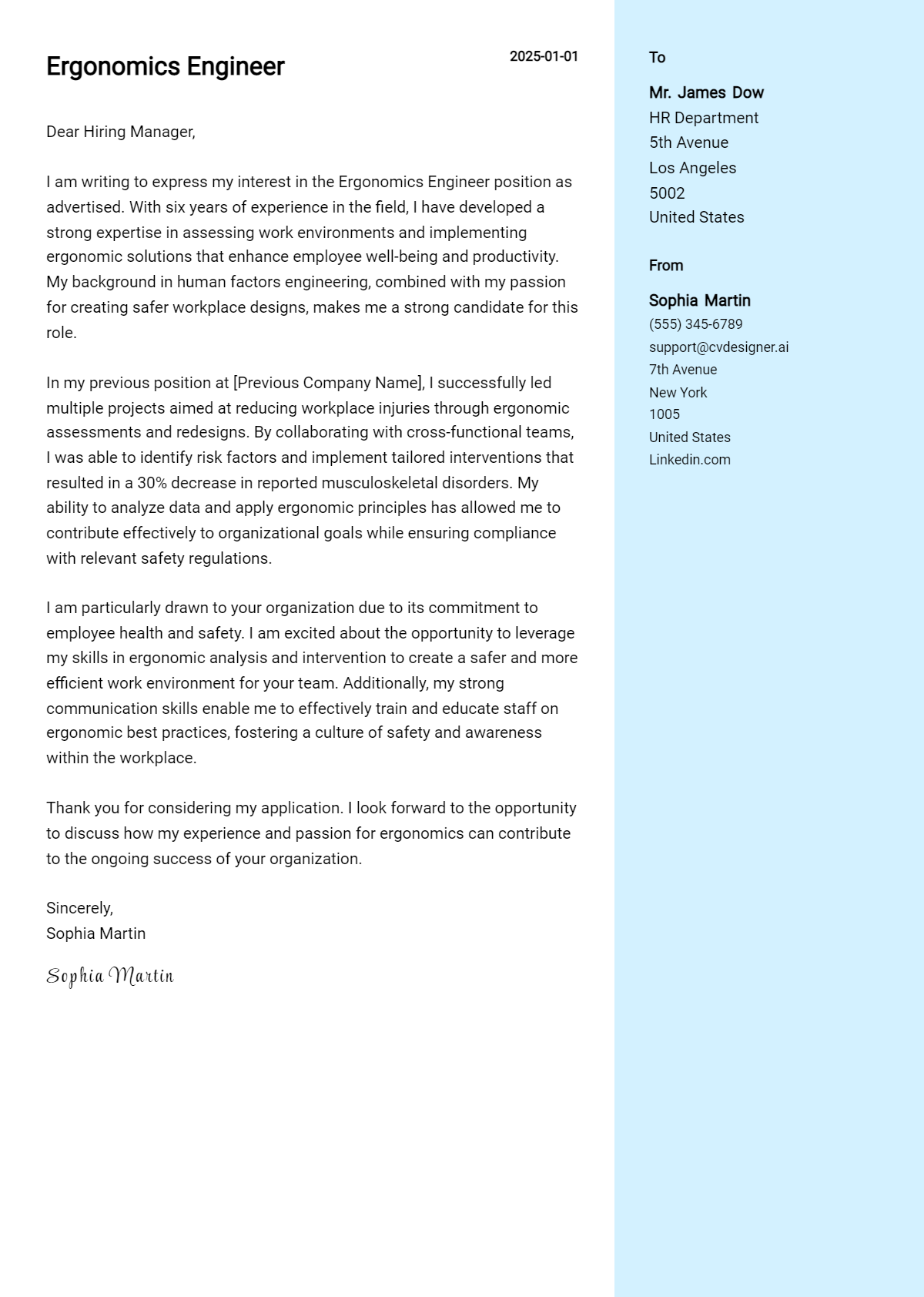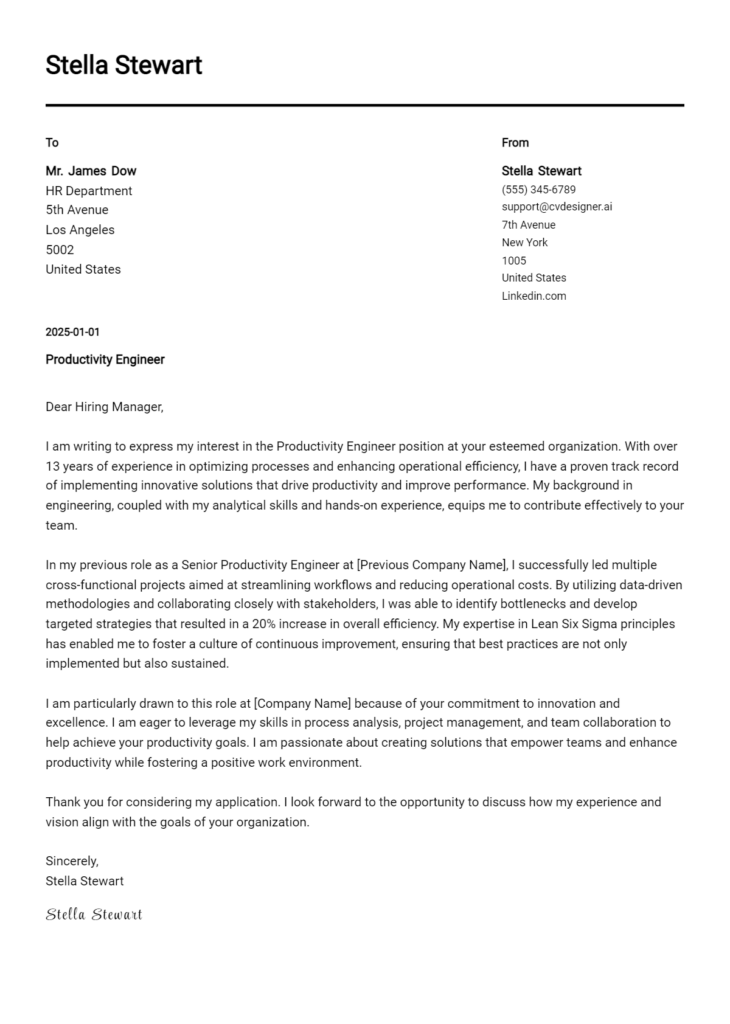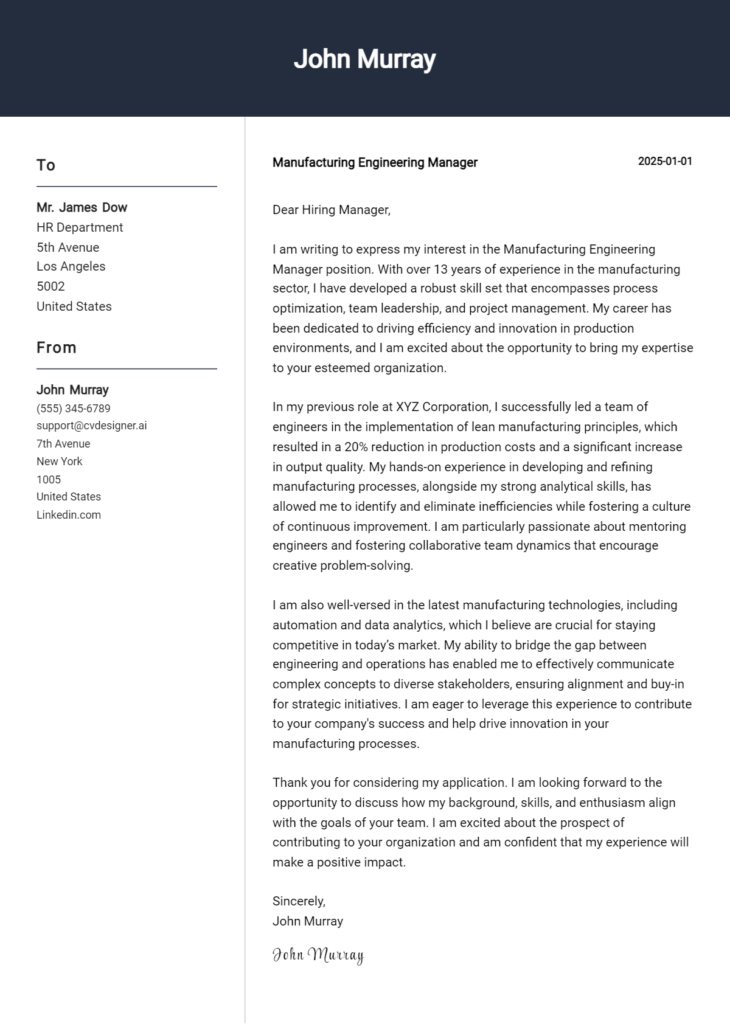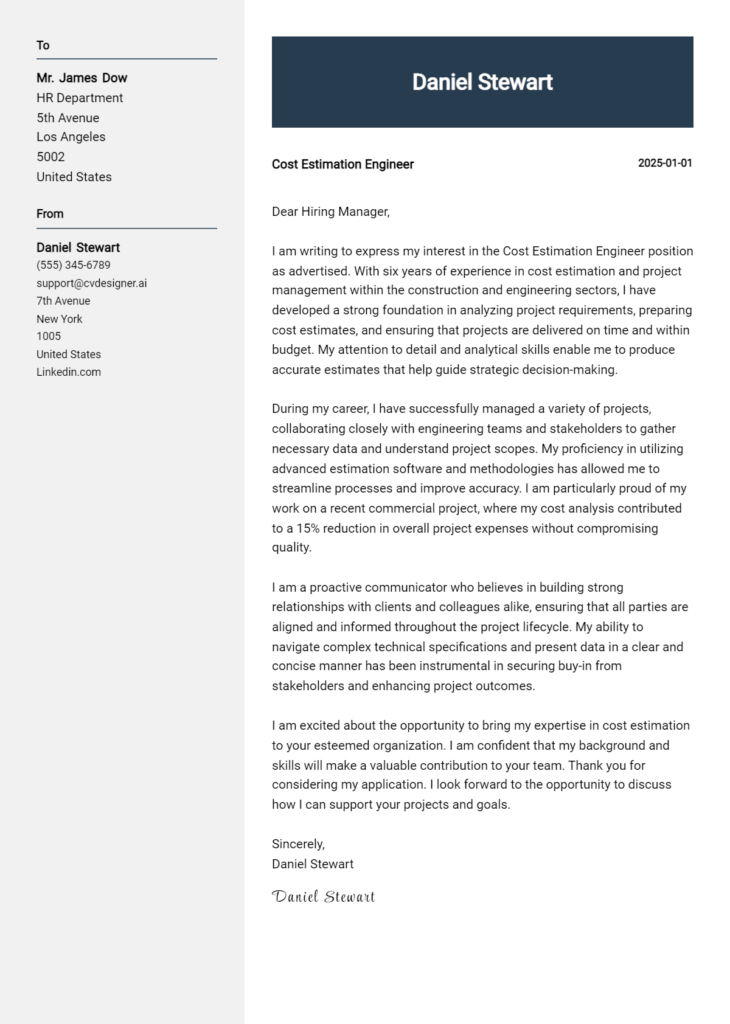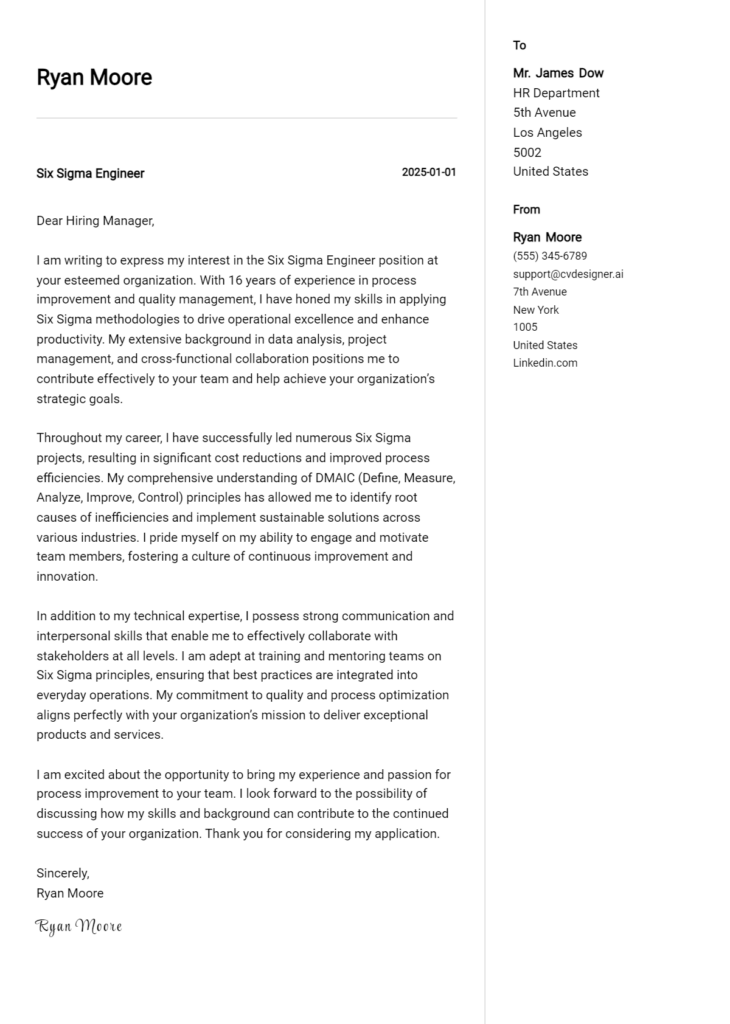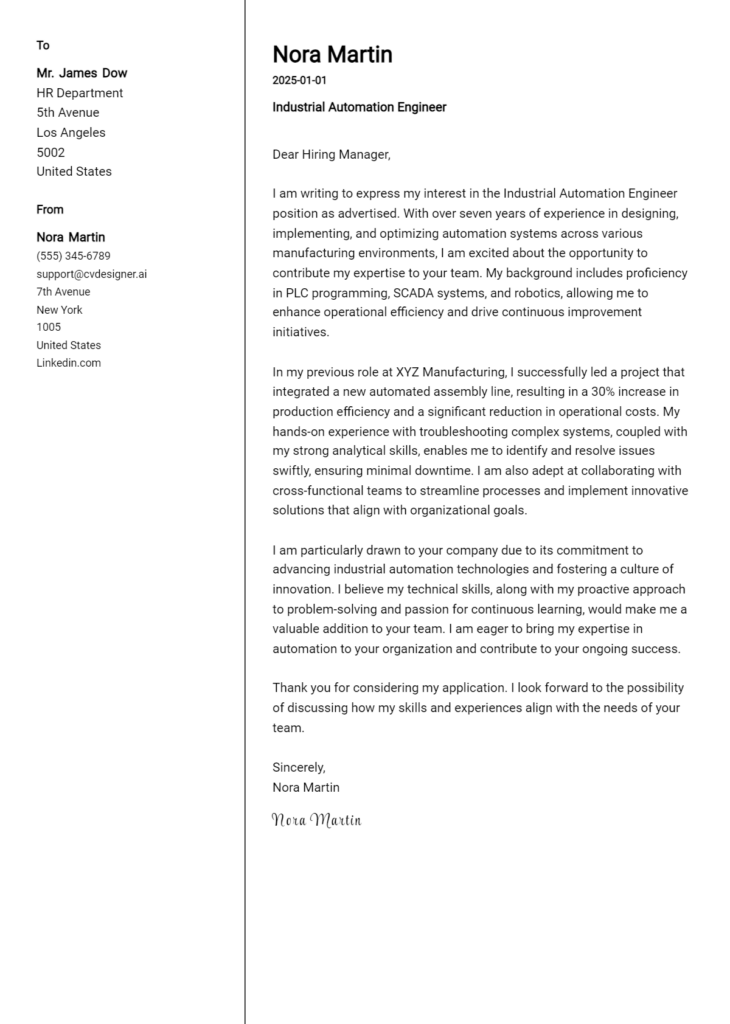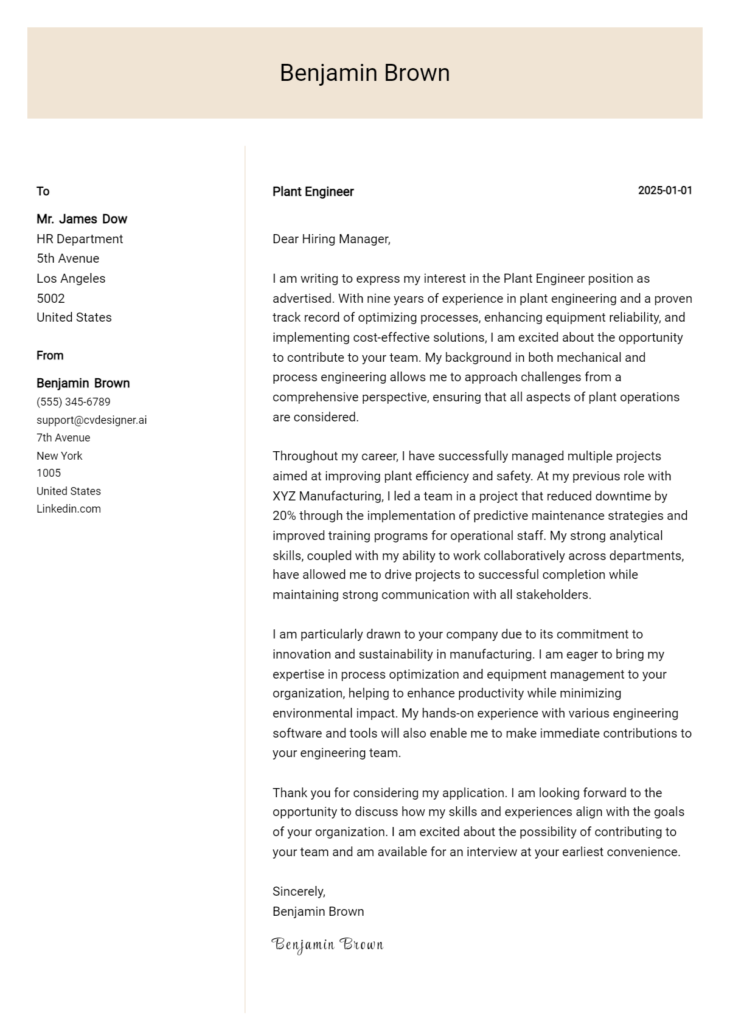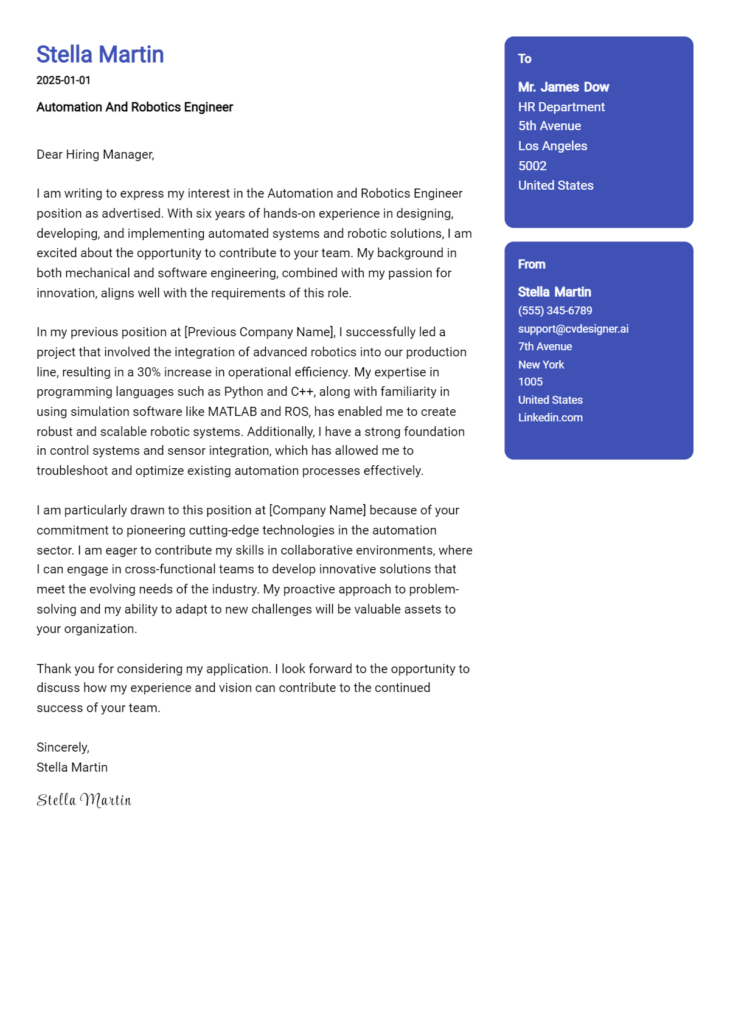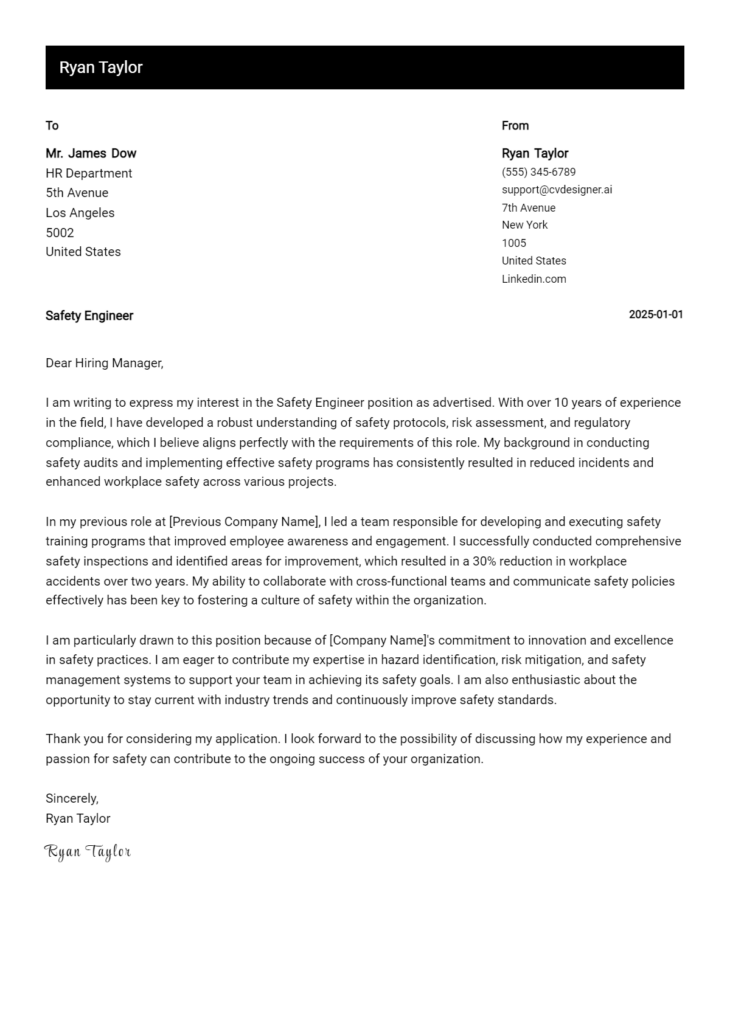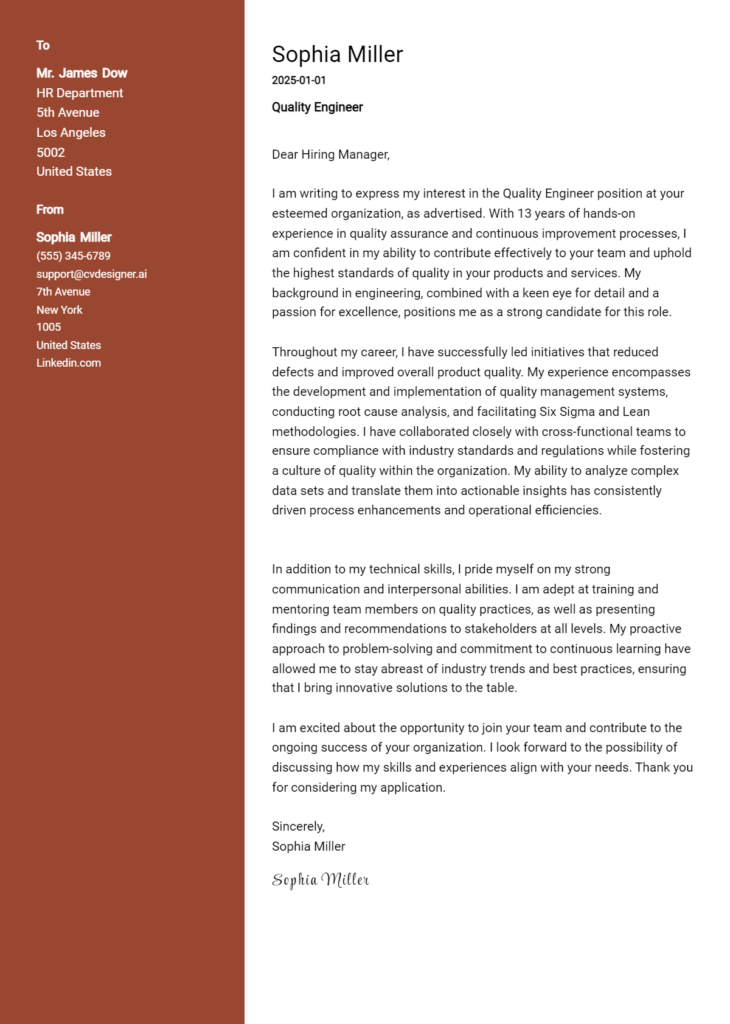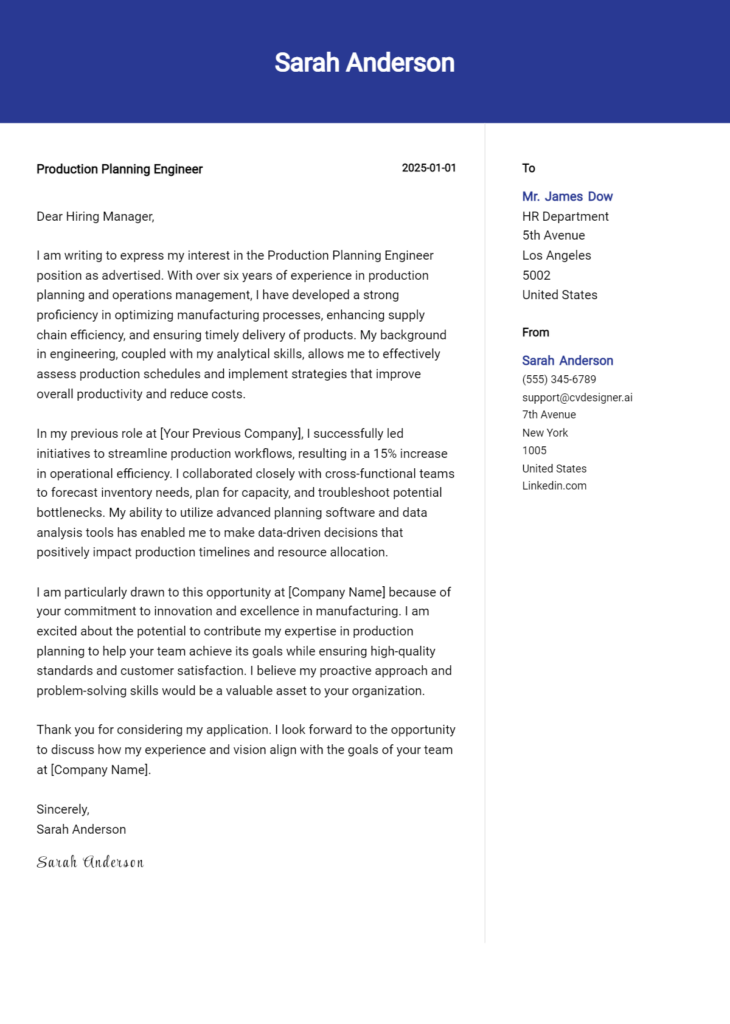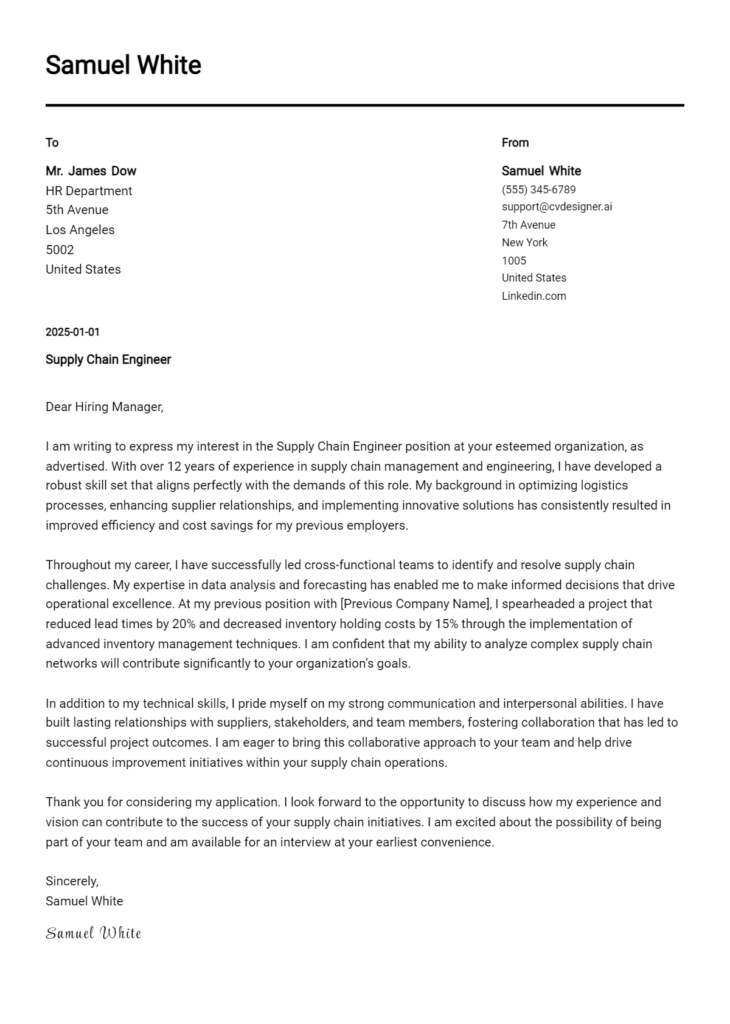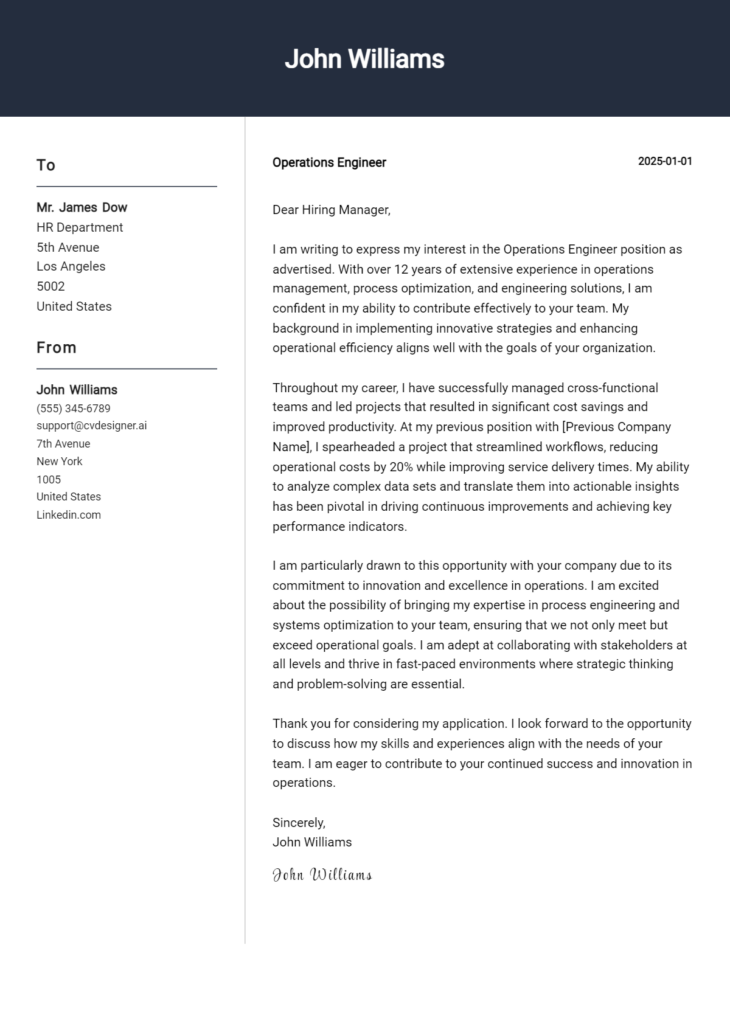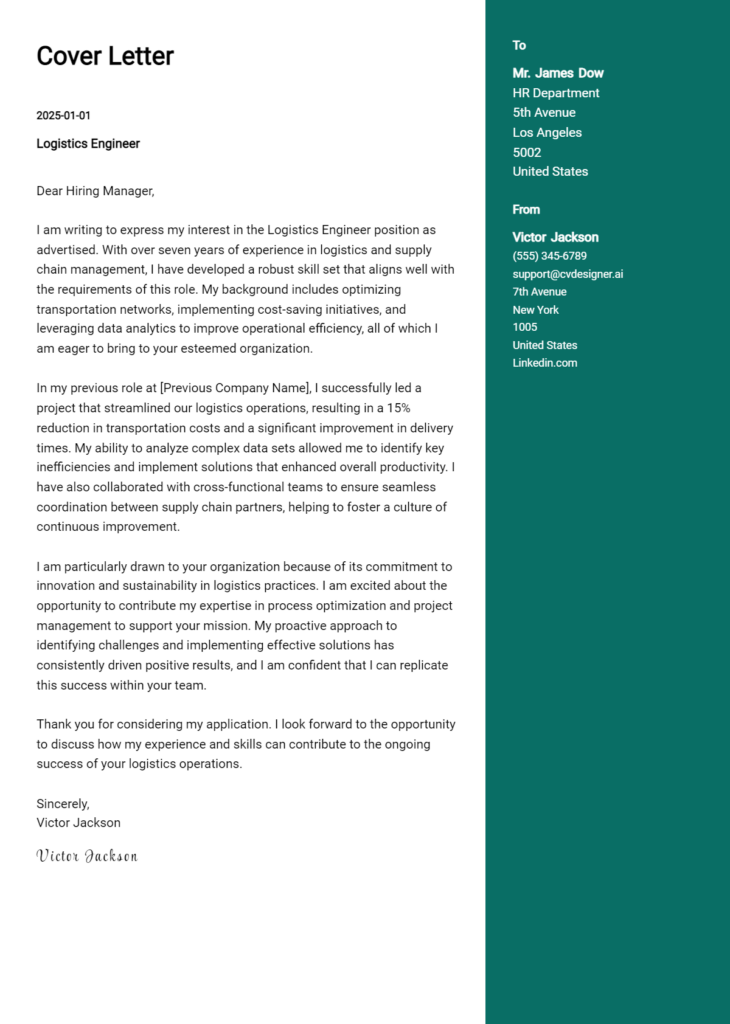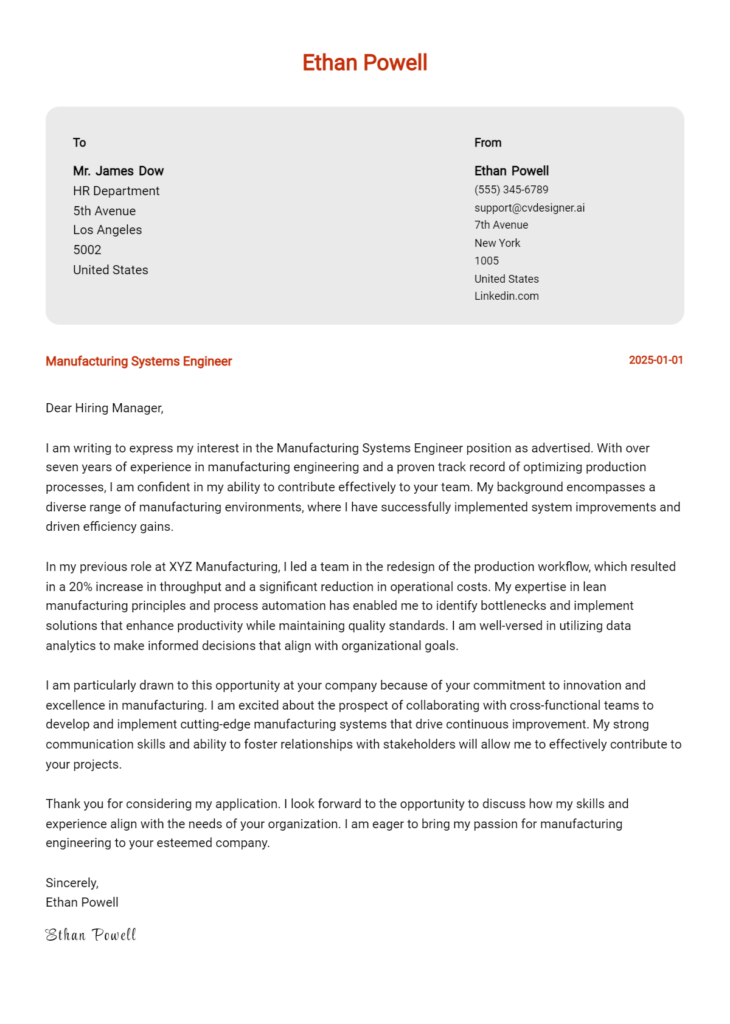Ergonomics Engineer Cover Letter Examples
Explore additional Ergonomics Engineer cover letter samples and guides and see what works for your level of experience or role.
How to Format an Ergonomics Engineer Cover Letter?
Crafting a standout cover letter is essential for Ergonomics Engineers, as it serves as a reflection of your analytical skills and understanding of workplace design principles. Proper formatting not only ensures clarity but also demonstrates your professionalism and attention to detail, traits that are critical in the field of ergonomics. A well-structured cover letter can effectively convey your qualifications and passion for creating safer, more efficient work environments.
In this guide, we'll explore how to organize your cover letter, providing specific insights and ergonomics-focused examples to help you craft an engaging document.
We'll focus on the essential components of a professional cover letter, including:
- Cover Letter Header
- Cover Letter Greeting
- Cover Letter Introduction
- Cover Letter Body
- Cover Letter Closing
Each section is crucial for showcasing your expertise and professionalism. Let’s delve into each part and discover how to make your ergonomics engineer cover letter truly shine.
Importance of the Cover Letter Header for an Ergonomics Engineer
The cover letter header is a crucial component of your application as an Ergonomics Engineer. It sets the tone for your correspondence and establishes a professional first impression. A well-structured header should include your contact information, the date, and the recipient's details. This clarity not only makes it easy for hiring managers to reach you but also demonstrates your attention to detail—an essential trait for an ergonomics professional. Ensuring that your header is formatted correctly reflects your professionalism and organizational skills, which are critical in the field of ergonomics.
Strong Example:
John Doe 123 Ergonomics Lane Design City, ST 12345 john.doe@email.com (123) 456-7890 October 5, 2023 Ms. Jane Smith Hiring Manager Ergonomics Solutions Inc. 456 Workplace Ave Design City, ST 12345
Weak Example:
John D. johndoe@email.com 10/5/2023 Hi, Jane
Importance of the Cover Letter Greeting for an Ergonomics Engineer
The greeting of a cover letter is a crucial element that sets the tone for the entire document. It serves as the first point of contact between the candidate and the hiring manager, establishing a sense of professionalism and personalization right from the start. By addressing the hiring manager directly, you demonstrate respect and a genuine interest in the position, which can make a positive impression. Avoiding generic greetings like "To Whom It May Concern" is essential, as these can come off as impersonal and lazy. Instead, take the time to research the recipient's name, which can often be found on the company’s website or LinkedIn. This small effort can significantly enhance the effectiveness of your cover letter.
Strong Greeting Example
Dear Dr. Smith,
Weak Greeting Example
To Whom It May Concern,
Importance of a Well-Crafted Cover Letter Introduction for an Ergonomics Engineer
A well-crafted cover letter introduction is crucial for an Ergonomics Engineer, as it sets the tone for the entire application while capturing the hiring manager's attention. This opening paragraph should not only express genuine interest in the role but also highlight the candidate's relevant skills and achievements that make them a strong fit. A powerful introduction can distinguish a candidate from others, encouraging the reader to delve deeper into the rest of the cover letter. Below are examples of both strong and weak cover letter introductions for an Ergonomics Engineer position.
Strong Example
Dear [Hiring Manager's Name], As a passionate Ergonomics Engineer with over five years of experience in designing user-centered solutions that enhance workplace safety and productivity, I am excited to apply for the Ergonomics Engineer position at [Company Name]. My background in conducting comprehensive ergonomic assessments and implementing innovative design modifications has resulted in a 30% reduction in workplace injuries at my current organization, showcasing my commitment to improving employee well-being and efficiency. I am eager to bring my expertise to your team and contribute to [Company Name]'s mission of fostering a healthier work environment.
Weak Example
Hi there, I want to apply for the Ergonomics Engineer position. I have some experience in ergonomics and think I could do a good job. I’ve worked on a few projects that involved making things safer for people, which I guess is important. I hope you consider my application.
Purpose of the Cover Letter Body for an Ergonomics Engineer
The body of a cover letter for an Ergonomics Engineer serves as a critical platform to present the candidate’s relevant skills, experiences, and contributions to prospective employers. This section should effectively communicate how the candidate's background in ergonomics and human factors engineering aligns with the company's goals and needs. By detailing specific projects or accomplishments, the candidate can illustrate their expertise in creating safer and more efficient work environments, enhancing productivity, and reducing the risk of injury. A well-crafted cover letter body should not only highlight technical qualifications but also convey the candidate's passion for improving workplace ergonomics and overall employee well-being.
Strong Example
Dear Hiring Manager, I am excited to apply for the Ergonomics Engineer position at XYZ Corporation. With over five years of experience in developing ergonomic solutions for various industries, I successfully led a project that resulted in a 30% reduction in reported musculoskeletal disorders at ABC Manufacturing. By implementing workstation assessments and redesigning tools and equipment, my team and I improved employee comfort and productivity. Additionally, my background in conducting user research and applying ergonomic principles has enabled me to create tailored training programs that educate staff on best practices. I am eager to bring my expertise in ergonomics to XYZ Corporation, ensuring a safer and more efficient workplace for all employees. Sincerely, [Your Name]
Weak Example
Dear Hiring Manager, I am interested in the Ergonomics Engineer position at your company. I have some experience in ergonomics and have worked on a few projects. I think I would be a good fit for your team. I want to help people work better and make things safer. I hope to hear back from you soon. Best, [Your Name]
Importance of the Cover Letter Closing for an Ergonomics Engineer
The closing paragraph of a cover letter is a critical component, especially for an Ergonomics Engineer, as it provides an opportunity to summarize qualifications, reiterate interest in the role, and encourage the hiring manager to take the next steps. A strong closing can reinforce why you are the ideal candidate and prompt them to review your resume or schedule an interview. Conversely, a weak closing may leave the reader unconvinced and less inclined to pursue your application further.
Strong Example
Thank you for considering my application for the Ergonomics Engineer position. With my extensive background in ergonomic design and human factors engineering, coupled with my passion for improving workplace safety and efficiency, I am excited about the opportunity to contribute to your team. I look forward to the possibility of discussing my qualifications in more detail and how I can support your organization’s goals. Please feel free to contact me to schedule an interview at your convenience. I am eager to share my insights and experiences with you.
Weak Example
Thanks for reading my cover letter. I hope you find my resume interesting. I would like to work for your company because it seems like a good place. Please let me know if you want to talk more.
Crafting an effective cover letter is essential for candidates applying for the role of Ergonomics Engineer. A well-written cover letter not only highlights your qualifications but also reflects your understanding of the discipline and your enthusiasm for the field. By emphasizing your technical skills, problem-solving abilities, knowledge of the Software Development Life Cycle (SDLC), teamwork capabilities, and a commitment to continuous learning, you can create a compelling narrative that sets you apart from other candidates. Here are five detailed tips to help you write an outstanding cover letter for the Ergonomics Engineer position.
Tips for Writing an Effective Cover Letter
Showcase Your Technical Skills
Clearly articulate your technical proficiencies relevant to ergonomics engineering. Mention specific software tools, methodologies, or frameworks you are familiar with, such as CAD software for design, statistical analysis tools, or human factors engineering principles. Highlight any certifications you hold that bolster your qualifications. This will demonstrate your readiness to tackle the technical aspects of the role.Emphasize Problem-Solving Abilities
Ergonomics engineers are often faced with complex challenges that require innovative solutions. In your cover letter, provide examples of past projects where you successfully identified ergonomic issues and implemented effective solutions. Use quantifiable outcomes to illustrate the impact of your work, such as improved productivity or reduced injury rates, showcasing your analytical thinking and problem-solving skills.Demonstrate Knowledge of SDLC
Familiarity with the Software Development Life Cycle (SDLC) is crucial, especially if your role involves software development or integration in ergonomic solutions. Mention any experiences you have working within SDLC frameworks, highlighting your understanding of each phase from planning to deployment. This knowledge will reassure employers of your capability to contribute effectively to interdisciplinary teams focused on ergonomic improvements.Highlight Teamwork and Collaboration
Ergonomics engineering often requires collaboration with various stakeholders, including designers, engineers, health professionals, and clients. Use your cover letter to discuss instances where you successfully worked within a team to achieve common goals. Emphasize your communication skills and ability to incorporate feedback, demonstrating that you are a team player who values collaboration in achieving ergonomic excellence.Express a Passion for Continuous Learning
The field of ergonomics is constantly evolving, driven by advancements in technology and research. Convey your commitment to professional development by mentioning any ongoing education, workshops, or certifications you are pursuing. This not only showcases your dedication to staying updated with industry trends but also reflects your enthusiasm for contributing to innovative ergonomic solutions.
By applying these tips in your cover letter, you can create a strong impression on potential employers. For additional resources, consider utilizing cover letter templates and a cover letter builder to streamline your writing process and ensure your application stands out.
Common Mistakes to Avoid in an Ergonomics Engineer Cover Letter
Crafting a compelling cover letter is crucial for standing out in the competitive field of ergonomics engineering. Avoiding common mistakes can enhance your chances of making a positive impression on potential employers. Here are some common pitfalls to watch out for:
Generic Salutation: Using a vague greeting such as "To Whom It May Concern" can make your application seem impersonal. Always try to find the hiring manager's name or use a specific title.
Lack of Specificity: Failing to tailor your cover letter to the specific job can make it seem like you’re sending a form letter. Reference the job description and highlight relevant skills and experiences that align with the position.
Overemphasis on Responsibilities: Many candidates focus too much on past job duties rather than accomplishments. Instead, showcase how your contributions positively impacted previous employers or projects.
Ignoring Formatting Guidelines: Presenting your cover letter in an unprofessional format can detract from your message. For tips on how to structure your document, refer to cover letter format.
Typos and Grammatical Errors: Mistakes in spelling or grammar can signal carelessness. Always proofread your letter multiple times and consider using tools or a friend for a fresh perspective.
Failing to Convey Passion for Ergonomics: Employers want to see your enthusiasm for the field. Include a brief statement about what draws you to ergonomics engineering and why you want to work for their company.
Neglecting to Include a Call to Action: A strong closing statement encourages the hiring manager to take the next step. Politely express your eagerness for an interview and mention your availability.
By avoiding these common mistakes, your cover letter can effectively showcase your qualifications and passion for the role. For inspiration, check out some cover letter examples that can guide you in creating a standout application.
Cover Letter FAQs for Ergonomics Engineer
What should I include in my cover letter as an Ergonomics Engineer?
In your cover letter, you should highlight your educational background and relevant experience in ergonomics or related fields. Discuss specific projects where you've successfully implemented ergonomic solutions that improved workplace safety and productivity. Mention any certifications, such as Certified Professional Ergonomist (CPE), that demonstrate your expertise. It’s also beneficial to convey your passion for ergonomics and how it aligns with the company's mission. Tailoring your cover letter to reflect the specific job description, including key responsibilities and desired skills, will show prospective employers that you have done your homework and are genuinely interested in the role.
How can I demonstrate my technical skills in my cover letter?
To effectively showcase your technical skills in your cover letter, provide concrete examples of how you've applied those skills in past positions. For instance, mention specific software tools you are proficient in, such as CAD for design or ergonomic assessment tools for evaluating workstations. Discuss your experience with conducting ergonomic assessments, analyzing data, and recommending solutions to improve workplace ergonomics. Additionally, if you have experience conducting training sessions or workshops on ergonomic practices, include that as it demonstrates your ability to communicate technical information effectively.
Should I mention my soft skills in my cover letter?
Absolutely! Soft skills are crucial for an Ergonomics Engineer, as your role often involves collaboration with cross-functional teams, clients, and stakeholders. Highlight skills like communication, problem-solving, and teamwork, and support these claims with specific examples. For instance, you might describe how you facilitated a workshop to educate employees about ergonomic practices or how you collaborated with design teams to create ergonomic products. Emphasizing your ability to navigate interpersonal dynamics and advocate for ergonomic solutions can set you apart from other candidates, showcasing that you are not only technically proficient but also a valuable team player.
How can I tailor my cover letter for a specific ergonomics position?
To tailor your cover letter for a specific ergonomics position, carefully analyze the job description and identify the key qualifications and responsibilities. Use this information to customize your letter by incorporating relevant keywords and phrases that reflect the company’s needs. For example, if the job emphasizes the importance of workplace assessments, you might elaborate on your experience conducting those assessments and the positive outcomes achieved. Additionally, research the company’s culture and values, and mention how your professional philosophy aligns with them. This personalized approach demonstrates your genuine interest in the position and can significantly enhance your chances of making a positive impression.
Build your Cover Letter in minutes
Use an AI-powered cover letter builder and have your letter done in 5 minutes. Just select your template and our software will guide you through the process.

